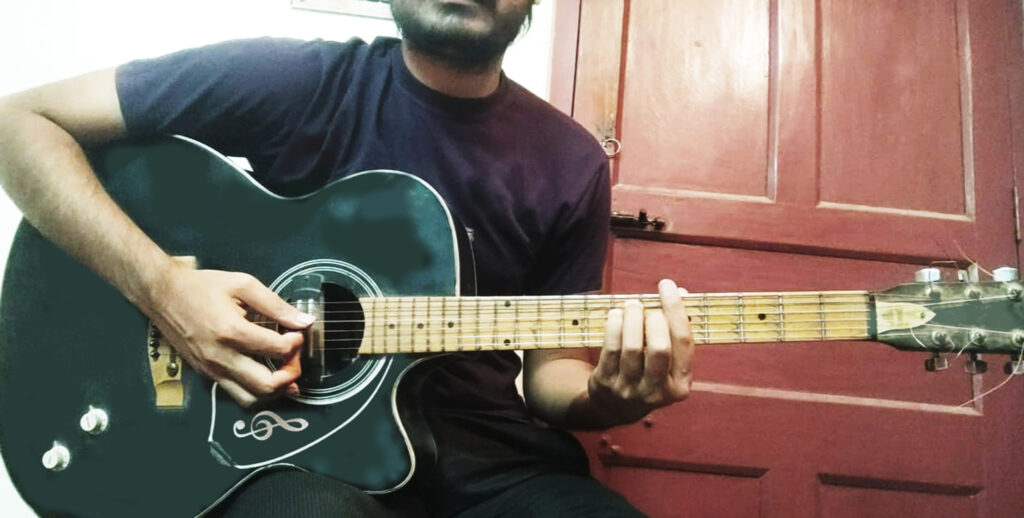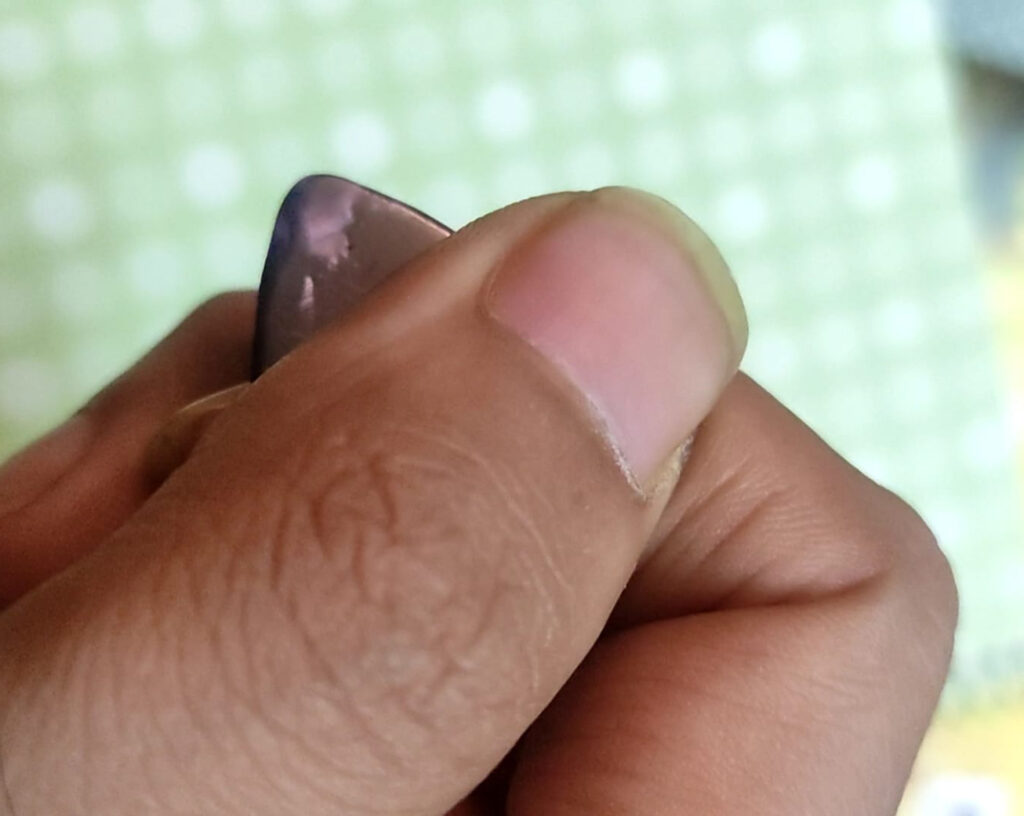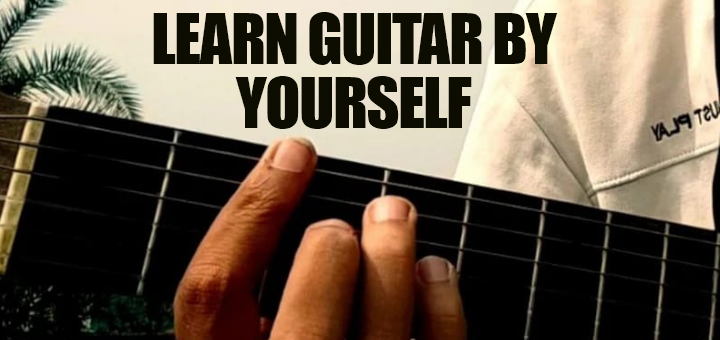Learning To Play The Guitar by Yourself
Learning to play the guitar by yourself is not so hard in today’s world. There are lots of lessons that can find on the internet. The main problem is what to learn. Like a sea, there is lots of water but is it drinkable to you? or how is it purified? Similarly, some guitar lessons on the internet will not work for you. It may cost time wasting, hand injury, and a lack of interest in the guitar. The secret to playing an instrument is synchronizing two hands with the mind. Concentrate on breathing while playing. Try to watch the guitar before playing. Those points will help anybody before they start to play the guitar. Here we are discussing Six essential topics of playing the guitar.
Contents
Standing or sitting with the instrument in your hands is called posture. This lesson may be the same for everybody from beginner to virtuoso. The correct way to sit with the guitar is called a good posture. If you are not in the proper posture, it may create some physical issues like back pain, neck problem, etc. Playing the guitar for a long time with the correct posture may also be easier to play the guitar. Grab the guitar first with confidence. Standing while playing the guitar requires a strap or maybe a stand-up guitar holder. To play guitar, usually seated on a chair. Most of us play the guitar when we are sitting anywhere. So now place your guitar on the right knee for right-hand guitar players. Remember, for a “classical guitar” player, place your guitar on the left knee with proper posture, but if you are playing a “steel-string acoustic guitar,” you can put your guitar on the right knee. For now, we can discuss “steel-string acoustic guitar.” After taking the guitar on the right knee, we take our right hand onto the guitar’s body and relax our left hand. For left-handed people, the hold will be vice versa. Keep trying to straighten your spinal cord and neck. Relax, and breathe slowly. Now you are ready to play.


Hold a pick
Let me straight; there is no particular way to hold a pick. Many of our greatest guitar heroes have strokes different from each other. The angle of the plectrum is essential. A 45-degree rotation of the guitar pick helps to play with speed while paying lead. The rhythm is excellent with the flat guitar pick. It’s nearly holding a pen. But it is slightly different. Take your guitar pick and place it inside your thumb and index finger. Try to make minimum pressure to hold the guitar pick. It may fall sometimes, but it is more effective than gripping a guitar pick with a significantly tightened hand. Make sure that you can move your hands very comfortably. Images are shown below.


Strings
Strings are Open string names that are essential to know for any instrument. It helps to tune the guitar. Acoustic guitars usually have six strings. In order of thickness, strings are thickest at the bottom and thinnest at the top. There are five guitar strings based on their material catgut, nylon, silver-plated copper, bronze, and nylon. Acoustic steel string guitars generally use steel and bronze strings. Classical guitar strings build of nylon. It is also called a nylon string Guitar. There are six types of strings that can find for acoustic guitars. According to diameter from lowest to highest, How to choose the most suitable string gauge based on six types of strings. The diameter of the strings is sorted from the lowest to the highest, starting with Super light, Extra light, Custom Light, Light gauge, Medium gauge, and Hard gauge. From my personal experience, I suggest Extra light and a light gauge for beginners and a medium gauge for advanced playing.
| Strings | Diameter(inch) | Pros | Cons |
| Super light | .009-.042 | 1. Easy to bend. 2. Need Low pressure to play a note. 3. Produce the brightest tone for the guitar. | 1. Low volume and less sustainable sound. 2. Easy to break. 3. Tones are not good. |
| Extra light | .010-.047 | 1. Good for beginners, 2. Do not affect guitar action. 3. B.B kings like vibrato can be done. | 1. Chords do not sound rich. 2. String breakage. 3. Less loud sound. |
| Custom Light | .011-.052 | 1. Hybrid gauge by D’Addario. 2. Less tension on 1,2 strings. 3. Easy to vibrato. | 1. Not so a variety of strings. 2. Strings became rusty quickly. 3. Not good for long time usage. |
| Light gauge | .012-.053 | 1. Smooth string. 2. Sounds are more sustainable. 3. Easy to use any guitar technique. | 1. Be aware of the duplicate products. 2. Need more pressure than an extra light gauge to produce sound. 3. Less resistance against fingers. |
| Medium gauge | .013-.056 | 1. It sounds depth and clear. 2. Hard strumming. 3. Hard to break. | 1. Not so good for beginners. 2. Create more tension to produce sound. 3. It may change guitar action. |
| Heavy gauge | .014-.069 | 1. Great sound. 2. Almost unbreakable. 3. Good for drop tuning. | 1. It can change guitar action from low to high. 2. May create physical hand pain. 3. Hard to use any guitar technique. |
Tuning
Tuning is an essential lesson for every guitarist.” Guitar in tune” means that your Guitar is ready to play. There was a time when it took a lot of work for many guitarists to tune their guitars perfectly. In other words, we can “play guitar by yourself.” No apps, no mobile phones could do that. Earlier, all the tuning did by ear. But now the game is changing. With a smartphone, digital tuner, or even a website, you can easily tune your Guitar. Now every beginner can tune their Guitar as well. Each of those six strings is different from the others. They tune in at a particular frequency .440 Hz. is the standard frequency for tuning a guitar.
Standard Tuning
- 6th string-“E”
- 5th string-“A”
- 4th string-“D”
- 3rd string-“G”
- 2nd string-“B”
- 1st string-“E”
It can be slightly different with a smartphone tuner. Tuning a guitar with a smartphone is like this.
Standard Tuning for Mobile
- 6th string-“E2”
- 5th string-“A2”
- 4th string-“D3”
- 3rd string-“G3”
- 2nd string-“B3”
- 1st string- “E4”
Strokes
In an acoustic guitar, hitting the string with a pick is called stoke. The angle of the guitar pick is essential when it hits the guitar string. There is the possibility of producing louder or softer sounds with the pressure of picking hands. We have only two-stroke “up and down.” When the plectrum moves upside to produce sound, it’s called “upstroke,” and moving downside, it makes down stoke. Try to make strokes with slight edges of the pick, not too flat. We avoided “three-sided plectrum.”Push the string near the guitar hole, and do not try to pull the strings. With minimal pressure, you can produce great sound.
Guitar Tab
Guitar Tab (Tabulature or “tab” ) is a musical notation that indicates strings and frets more than musical notes. It only shows fret numbers with note duration. There are some musical symbols. It has six lines like guitar strings. The upper one is the 6th string, and the lower one is the 1st string. Underneath the fret number, there is a note value. To understand tab notation, you do not need to know the names of musical notes. For more about the guitar tab, check this.
Example:

In conclusion,
Learning to play the guitar by yourself is possible. It takes some time. A process needs some patience to get that mastery. So don’t hurry. For your suggestion, comment below. Thank you.








Your mode of explaining the whole thing in this paragraph
is really fastidious, every one be capable of without difficulty be aware of
it, Thanks a lot.
Thank you for your concern. Keep in touch.?
It’s a pity you don’t have a donate button! I’d most certainly donate to this
brilliant blog! I suppose for now i’ll settle for bookmarking and adding your RSS feed to my Google account.
I look forward to new updates and will talk about this blog
with my Facebook group. Chat soon!
Thank you for your appreciation. It means a lot. Keep connecting. ?
Superb and well-thought-out content! If you need some information about SEO, then have a look at Article Home